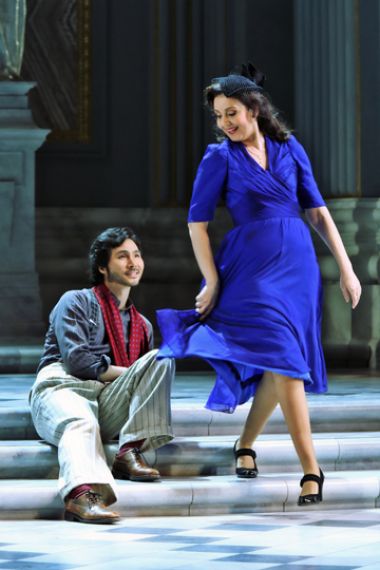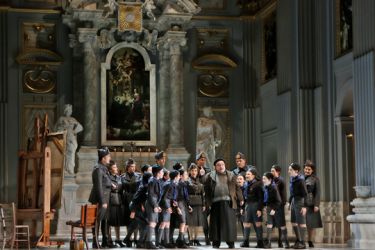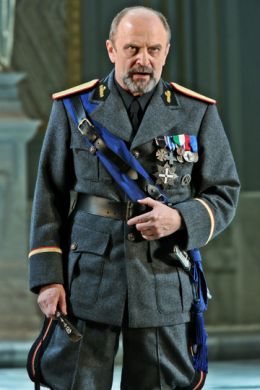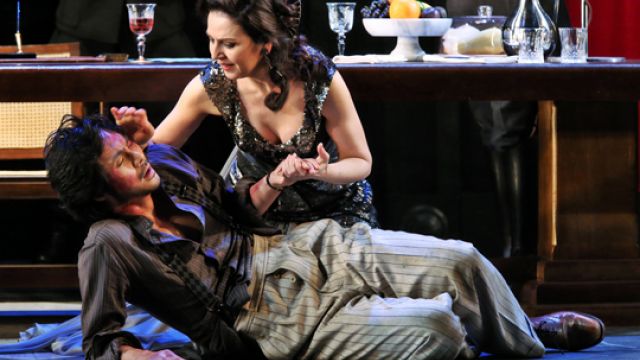Tosca
The Plot
Puccini’s opera, adapted from a play by French playwright Soudain, and first performed in 1900, is set in Rome in 1800 as Napoleon’s troops approach to free Rome from the long and tyrannical rule of the Kingdom of Naples.
Angelotti, who has just escaped from prison, hides in the Attavanti chapel of the Sant’Andrea dell Valle church. When he emerges, the artist Mario Cavaradossi, who is completing a painting of Mary Magdalene in the church, agrees to help him escape but tells him to hide when Tosca approaches.
Tosca suspects Cavaradossi of having an affair with the Marches Attavanti, but Cavaradossi assures her of his love in soaring notes that echo through the church. Convinced, Tosca leaves and Cavaradossi rushes Angelotti to the safety of his villa.

Baron Scarpia, hot on Angelotti’s trail, finds a fan with the Attavanti crest, which he uses to inflame Tosca’s jealousy in a ploy to win her for himself.
In the meantime, Cavaradossi has been arrested, but though he denies any knowledge of Angelotti’s escape, he is led away to be tortured just as Tosca arrives from a singing engagement. At first she refuses to tell Scarpia anything, but the moans of Cavaradossi off stage are too much and she reveals Angelotti’s hiding place.
She begs for the life of her lover, and finally agrees to Scarpia’s ‘price’, but only after he agrees to a mock execution for Cavaradossi and a letter of safe passage for them. As he begins to molest her, she stabs him and escapes with the letter.
Unfortunately the execution is real and when Tosca realises Scarpia has deceived her, she takes her own life.
This Production
With such a dramatic plot, and the powerful music that carries it, what an inspiration it was for director John Bell (Bell Shakespeare) to stage this production during the Nazi occupation of Rome in 1943-44!
The parallels are obvious.
Scarpia and his Napolian henchmen are cruel, ruthless and deceptive. Escape from their regime is almost impossible. Church and State have surrendered to them, just as Rome surrendered to German Field Marshall Kesselring in 1943. The people long for Napoleon to free them, just as Italy awaited the Allies in 1944.
Scarpia, Angelotto, Cavaradossi, Tosca, their dilemmas and their fates translate perfectly into this scene of Nazi occupation – and the sets (Michael Scott-Mitchell) and costumes (Terese Negroponte) make the translation beautifully credible.

In Act 1, the imposing marble columns of the Sant’Andrea dell Valle church arch above the stage. The detail of this set is stunning in its authenticity and beauty. Grey and white and gold abound, with Cavaradossi’s easel the only non- ecclesiastical artifact until Angelotti stumbles across the nave in his drab, striped prison clothes.
Tosca’s midnight blue dress is the only bright colour used in this Act, picking up the paler blues and greys in the set and contrasting with the somber grey of Scarpia’s Nazi uniform.
Act 2 is set inside the German headquarters. Red banners adorned with swastikas drape the grey walls and a long table stretches almost the width of the opera theatre stage. Here Scarpia taunts Tosca with Cavaradossi’s torture off stage and sees fear himself as news of the Allied invasion is heard and he sees the knife in Tosca’s hand.
 Act 3 opens in the courtyard of the German headquarters. Slowly, over almost six minutes, with the atmospheric music of the overture emphasisng the somberness of the scene, the lights come up on armed soldiers patrolling the high, grey, barb-wire festooned parapet, twenty three steps above the stage. Figures – a pleading family? – huddle in the foreground until hustled away.
Act 3 opens in the courtyard of the German headquarters. Slowly, over almost six minutes, with the atmospheric music of the overture emphasisng the somberness of the scene, the lights come up on armed soldiers patrolling the high, grey, barb-wire festooned parapet, twenty three steps above the stage. Figures – a pleading family? – huddle in the foreground until hustled away.
Cavaradossi is dragged in, bloody from torture, to be told of the mock execution and the planned escape by Tosca, dressed somberly all in black. She stands away as the five rifles of the execution squad are raised and fired.
Cavaradossi falls to the ground. The soldiers leave, hurriedly, fearing the Allies approach. When she is sure she is alone, Tosca rushes to Cavaradossi, applauding his acting, only to face Scarpia’s final deception in the dead body of her lover.
Bell’s direction of the final moment of the opera is stunningly effective – and I’m not going to spoil it!
Suffice to say that the standing ovation for John Wegner (Scarpia), Yonghoon Lee (Cavaradossi) and the tumultuous ovation for Alexia Voulgaridou’s Tosca was matched by the audience’s cheers and applause as John Bell and the designers joined the cast on the stage.
Tosca is a much-performed opera and those who may have decided to opt out seeing of yet another production have missed breathtaking performances, beautifully conducted music (Christian Badea), dramatically creative direction and three wonderful sets.
Carol Wimmer
Images (top two): Yonghoon Lee as Cavaradossi & Alexia Voulgaridou as Floria Tosca; John Bolton Wood as Sacristan & Opera Australia chorus and John Wegner as Scarpia. Photographer: Prudence Upton.
Subscribe to our E-Newsletter, buy our latest print edition or find a Performing Arts book at Book Nook.

